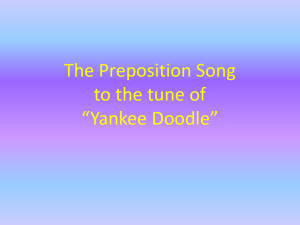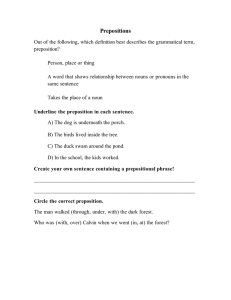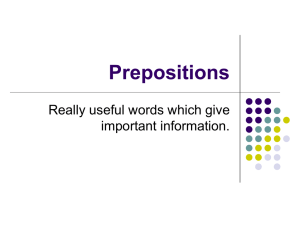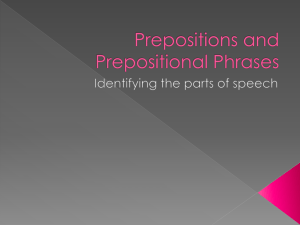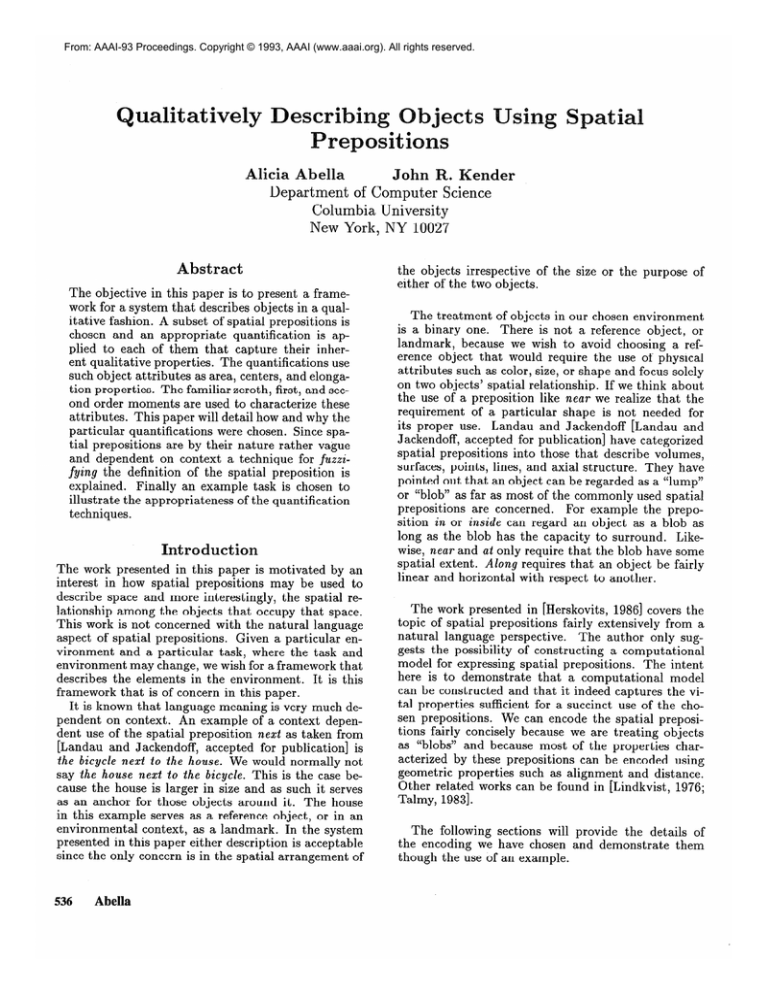
From: AAAI-93 Proceedings. Copyright © 1993, AAAI (www.aaai.org). All rights reserved.
ualitatively
Deseri
Alicia Abella
John R. Kender
Department of Computer Science
Columbia University
New York, NY 10027
Abstract
The objective in this paper is to present a framework for a system that describes objects in a qualitative fashion. A subset of spatial prepositions is
chosen and an appropriate
quantification
is applied to each of them that capture their inherent qualitative properties.
The quantifications
use
such object attributes as area, centers, and elongation properties.
The familiar zeroth, first, and second order moments are used to characterize these
attributes.
This paper will detail how and why the
particular quantifications
were chosen. Since spatial prepositions
are by their nature rather vague
and dependent on context a technique for fuzzifying the definition of the spatial preposition
is
explained.
Finally an example task is chosen to
illustrate the appropriateness
of the quantification
techniques.
Introduction
The work presented in this paper is motivated by an
interest in how spatial prepositions
may be used to
describe space and more interestingly,
the spatial relationship among the objects that occupy that space.
This work is not concerned with the natural language
aspect of spatial prepositions.
Given a particular environment and a particular
task, where the task and
environment may change, we wish for a framework that
describes the elements in the environment.
It is this
framework that is of concern in this paper.
It is known that language meaning is very much dependent on context.
An example of a context depennext as taken from
dent use of the spatial preposition
[Landau and Jackendoff,
accepted for publication]
is
the bicycle next to the house. We would normally not
say the house next to the bicycle. This is the case because the house is larger in size and as such it serves
as an anchor for those objects around it. The house
in this example serves as a reference object, or in an
environmental
context, as a landmark.
In the system
presented in this paper either description is acceptable
since the only concern is in the spatial arrangement
of
536
Abella
the objects irrespective
of the size or the purpose
either of the two objects.
of
The treatment of objects in our chosen environment
is a binary one. There is not a reference object,
or
landmark,
because we wish to avoid choosing a reference object that would require the use of physical
attributes such as color, size, or shape and focus solely
on two objects’ spatial relationship.
If we think about
the use of a preposition like near we realize that the
requirement
of a particular
shape is not needed for
its proper use. Landau and Jackendoff
[Landau and
Jackendoff,
accepted for publication]
have categorized
spatial prepositions
into those that describe volumes,
surfaces, points, lines, and axial structure.
They have
pointed out that an object can be regarded as a “lump”
or “blob” as far as most of the commonly used spatial
prepositions
are concerned.
For example the preposition in or inside can regard an object as a blob as
long as the blob has the capacity to surround.
Likewise, near and at only require that the blob have some
spatial extent. Along requires that an object be fairly
linear and horizontal with respect to another.
The work presented in [Herskovits, 1986] covers the
topic of spatial prepositions
fairly extensively
from a
natural language perspective.
The author only suggests the possibility of constructing
a computational
model for expressing spatial prepositions.
The intent
here is to demonstrate
that a computational
model
can be constructed
and that it indeed captures the vital properties sufficient for a succinct use of the chosen prepositions.
We can encode the spatial prepositions fairly concisely because we are treating objects
as “blobs” and because most of the properties
characterized by these prepositions
can be encoded using
geometric properties such as alignment and distance.
Other related works can be found in [Lindkvist,
1976;
Talmy, 19831.
The following sections will provide the details of
the encoding we have chosen and demonstrate
them
though the use of an example.
Notations
and Definitions
The prepositions
for which we have encoded are near,
far, inside, above, below, aligned, next. We have defined a preposition as a predicate that maps k objects
to true (T) or false (8’); true if the k objects meet
the requirements
imposed by the preposition and false
otherwise.
p : 0” -
{T, F)
where p is a preposition and 0” is a k-tuple of objects.
In this paper we will consider k = 2. Nevertheless,
prepositions that involve three objects like between can
also be represented,
using a similar formalism.
Now that we have defined a preposition we need to
define an object.
Formally, each object is represented
by a six element vector that depend on an object’s area
A, center
(xc, yC), and inertia
tensor
[ :;
;,y
]
It is important
to scale the elements in this vector
so that they have consistent units, in this case units of
length, because we will use this vector in the fuzzification procedure described in section 4. Therefore,
the
kth object is represented by a vector
The pair of objects
vector
p is represented
by a 1Zcomponent
p = (p’,p2) E7F2
It is this scaled vector that we will be using in our
future calculations.
The parameterization
of objects
presented
above
leads to the concept of a bounding box. A bounding
box encloses the object using certain criteria.
There
are various ways in which to compute a bounding box
for an object, one of which may be to find the maximum and minimum x and y values belonging to the
object.
The one we’ve chosen is defined through the
values of & and &, that offer a measure of how much
an object stretches in the x and y direction.
See the
Appendix for the derivation.
Two objects define a point in 12D space. A preposition p can be thought of as a set of points UP E RI2
such that UP = h-4Ph4~.
7% e volume in this 12D
space may be able to reveal some of the inherent propIn other words,
erties associated
with prepositions.
examination
of the space occupied by the various sets
U” may tell us something
about the spatial prepositions. Vacancies in this 12D space may reveal why we
do not have a word to describe certain spatial relationships among objects.
The intersection
and distances of
volumes occupied by various spatial prepositions
may
reveal a correlation between various prepositions.
We say that objects O1 and O2 are in preposition p
if ($, p2) E UP. This “ideal” set is made up of pairs of
object vectors that satisfy the constraints
imposed by
the preposition p. As we well know, prepositions
are
inherently vague in their descriptions,
and their interpretation may vary from person to person. Because of
this, it is important
to add some fuzzifying agent to
our ideal set. The fuzzifying technique is as defined
through fuzzy set theory [Klir and Folger, 19881. The
theory of fuzzy sets is used to represent uncertainty,
information,
and complexity.
The theory of classical
sets’ represents certainty.
A classical set divides objects in the world into two categories:
those that certainly belong to a set and those that certainly do not
belong to a set. A fuzzy set, on the other hand, divides
the world much more loosely, by introducing vagueness
into the categorization
process. This means that members of a set belong to that set to a greater or lesser
degree than other members of the set. Mathematically,
members of the set are assigned a membership
grade
value that indicates to what degree they belong to the
set. This membership grade is usually a real number in
the closed interval between 0 and 1. Therefore a member that has a membership grade closer to 1 belongs to
the set to a greater degree than a member with a lower
membership grade. Because of its properties fuzzy set
theory can find application
in fields that study how
we assimilate information,
recognize patterns [Abella,
19921, and simplify complex tasks.
In our notation
the fuzzified ideal set is defined through a membership
function
We also define a threshold value that depends on how
much vagueness we allow before we decide that two
objects are no longer describable with the given preposition:
fqh-4
L Qp
Computational
ode1 of’Spatial
Prepositions
The quantification
of prepositions
entails representing objects through certain physical properties
that
can then serve as a basis for expressing prepositions.
The physical properties
we’ve chosen include object
area, centers of mass, and elongation properties.
These
properties are calculated through the use of the zeroth,
first, and second order moments.
The basis for this
choice of attributes is simplicity and familiarity.
What
ensues is a brief description of the various prepositions
we’ve chosen to illustrate.
Each preposition is defined
through a set of inequalities.
This results in sets UP
having nonzero measure (i.e. full dimensionality)
in
R12 which is necessary for the fuzzification procedure
described in section 4.
NEAR
We’ve
defined
‘Referred
near so that
to as “crisp”
objects’
bounding
boxes
sets in fuzzy set theory.
Qualitative Reasoning
537
.:.
c.
,,‘: ‘,
:’
, ; . :
,’ :
: .\\\
2 I
, /”
,’
ex
‘\
‘\
‘\
D ‘.
Figure
1: Two objects
that
are near each other
.:.
clax
t9kin
/
,’ :
...........
.L(: ....‘I; Z*,..’
,’I’
a’
,I ,’
‘\I
Figure
,,; ;,f,, ,,,; _,/...~.’
.’
.’ : ..’__‘
’\\
: ,.’
,’
: ,:
: :
: :’ .
;....
.’
, ,*’
,’
\’
‘\\
I /?
3: Definition
FJ - EZ > Id -4
_.__._._
1:_...........
,’
,’
.’
#’
eLn
_....‘
.
*’
of relevant
be completely embedded
another. Formally,
ABOVE,
82
within
andEi
angles for aligned
the bounding
box of
-E,2 > IYE -~,2l
BELOW
Above requires that the projections
of bounding boxes
on the x axis intersect
and that the projections
of
bounding boxes on the y axis do not intersect.
The
mathematical
relationship is
Fi + c: > Id - x:1 and Ei + tjj < yi - yz
‘I
Figure
2: Two objects
that are far from each other
have a non-empty
intersection
matically this is :
(see figure
t: + 6: > Id -x:landt;+t;>
1).
Mathe-
IYE-YPI
FAR
Far is not the complement of near as one may initially
suspect. We may be faced with a case where an object
is neither near or far from another object, but rather
it is somewhat near or somewhat far. This notion of
somewhat will be explained more fully when we introduce the concept of fuzzifying our “ideal” set. For now
it suffices to say that far is defined so that the distance
between two bounding boxes in either the x extent or
the y extent is larger than the maximum length of the
two objects in that same x or y extent (see figure 2).
Mathematically,
Note that above is non-commutative.
We define below similarly. As with near and far, above and below are
mutually exclusive prepositions.
However, not- above
does not strictly imply below.
ALIGNED
The alignment2 property is angular in nature, therefore
its quantification
involves inequalities between angles,
rather than lengths as the previous prepositions
had.
For this purpose we define a different type of bounding
box that is centered at the object’s center of mass and
oriented along the object’s principal inertia axes with
dimensions proportional to the object’s maximum and
minimum moments of inertia. 0, emin and 8,,,
are as
shown in figure 3. With this in mind, the preposition
aligned is defined as:
max(elt7in 7Oii,)
< Bi < min(Ok,,,
O:,,),
i = 1,2
NEXT
We’ve defined next as a combination of the prepositions
near and aligned. Therefore the definition for next is:
u next -
Unear
n Ualigned
The preposition
next is an example of a spatial
preposition that is a combination
of more elementary
INSIDE
Inside
538
requires
AbeUa
that
the bounding
box of one object
2Although not a preposition from a language
we’ve adopted it as a spatial preposition.
perspective
This hints at the possibility
of a natprepositions.
ural hierarchy of spatial prepositions.
It also shows
evidence of the possible partitioning
of the 12D space
mentioned previously.
ification of Spatial
repositions
The
This section describes why and how we fuzzify spatial
prepositions.
We need to fuzzify spatial prepositions
because they are vague by their very nature; they depend on context and depend on an individual’s perception of them with respect to an environment.
For these
reasons we need to allow for some leeway when deciding
if two objects are related through a given preposition.
There is a lot of freedom in how we can fuzzify spatial prepositions,
or equivalently,
the “ideal” set, UP.
The idea we have adopted is to define the membership function fv,(p)
where ~1E RI2 as a function of a
distance d between ~1 and Up.
Figure
Note that d(p, Up) = 0 for p E Up. The distance d
tells us by how much the defining preposition inequalities are not satisfied. Thus,
h,
(r-l) = 1 for p E up
fu,(P) - 0 as 4% up>- ca
Up is a multi-dimensional
set defined by complex inequalities,
for which computing
d may be very burFor this reason we resort to a Montedensome.
Carlo simulation with a set of random points around
p that have given statistical
properties.
The experiments we’ve conducted use normally distributed
random points with mean ~1 and covariance matrix diag
(9) . ..) a2). The exact form for fu, used is
c
P E UP
f 19
where N is the total
Monte-Carlo
number
simulation
of random
points in the
and N’ is the number of points
p’ E Up. Note that the formulation of fu,ensures that
fu, for p very close to the boundary of Up will have a
value close to 1.
The following section will detail some experiments
that use this fuzzification technique and put into effect
the inequalities
that define the given spatial prepositions.
ualitative
escription
Experiments
We will use the image shown in figure 4 to illustrate
several uses of the prepositions.
Each object has been
numbered to ease their reference.
The image is read
as a grey-scale pixel image. It is then thresholded
to
produce a binary image and objects are located using a
sequential labelling algorithm [Horn, 19891. Once the
objects in the scene have been found, the attributes
4: The experimental
image
necessary for construction of the 12-dimensional
vector
are computed (e.g. the area of an object is the sum of
all the pixels belonging to the object).
Currently the
system accepts a spatial preposition
and displays all
those objects that satisfy the preposition inequalities.
The system also accepts as input two objects
along
with a preposition and it outputs how well those two
objects meet the given preposition
(the value of fu,
for given a). All intuitively obvious relations between
objects are discovered by the system, e.g. objects
1
and 3 are next to each other, etc.
An interesting case, and one that demonstrates
the
effects of fuzzification is the case of supplying object 2
and object 6 along with the preposition
aligned. With
no fuzzification the system finds that 2 and 6 are not
aligned. However, if we allow a certain amount of fuzzification with say (T = 0.03 the value of fUaliglaed is
0.8. This value indicates that they may be sufficiently
aligned to be regarded as such (which we actually see
in the image!), depending on how much leeway we wish
to allow. The dependency of fUaliglaed on (r is shown
in figure 5. From this graph we see that the value of
the membership function significantly
deteriorates
for
large values of 0. This simply means that the amount
of induced uncertainty is so large that the objects cease
to possess their original features (such as orientation
in this case).
This also indicates what the maximal
acceptable value for (T should be. In this case, that is
0 < 0.1.
Another interesting case is that of supplying object
2 and object 6 along with the preposition
near or far.
Neither satisfies the inequalities precisely. However, if
we again, allow for fuzzification,
we get a most interesting result, as shown in figure 6. We observe that
Qualitative Reasoning
539
scriptions.
In other words, we may wish to describe a
particular object with as few descriptions
as possible
through the feedback from the system. The goal would
be to home in on the object we are truly referring to
through repeatedly supplying additional prepositions
to those objects that were singled out after previous inquires. An experiment using this technique may reveal
that people naturally describe spatial arrangements
in
a series of descriptions,
rather than once and for all. It
may also demonstrate
inadequacies
in the vocabulary
or complexity of a scene. We may also discover that
certain environments
require that we adopt prepositions that do not exist in the English language for describing a particular sort of spatial arrangement.
fUP
Figure
5: The dependency
of
fUalioned
(2,6)
as a func-
tion of 0
References
Abella, A. 1992. Extracting
geometric
set of points. In Image Understanding
shapes from a
Workshop.
Herskovits, A. 1986. Language and spatial cognition:
An interdisciplinary
study of the prepositions
in English. Cambridge University Press.
Born,
Press.
Berthold
K.P.
1989.
Robot
Vision.
Klir, G. J. and Folger, T. A. 1988.
Prentice
certainty, and Information.
Landau,
“Where”
BBS.
The
Fuzzy Sets,
Hall.
MIT
Un-
B. and Jackendoff,
R. ation.
“What”
and
in spatial language and spatial cognition.
Lindkvist, K. 1976. Comprehensive
study of conceptions of locality in which English prepositions
occur.
Almqvist & Wiksell International.
Figure
6:
The
dependency
of 0
of
fu,,,,
(2,6)
and
fufaT(2,
6) as a function
although we can not say for certain that object 2 and
object 6 are either near or far, we can say that they
are somewhat near or somewhat far. How we decide
which of the two to use can be seen in figure 6. If we
examine the slopes of the two curves we see that for
small values of a the slope for .far is steeper than that
for near. Therefore it would seem more appropriate to
say that 2 is somewhat far from 6 as opposed to 2 is
somewhat near to 6.
Conclusion
The intent of this paper was to establish a computaspatial prepositions for
tional model for characterizing
use in describing objects.
A quantification
was established and demonstrated
through the use of an example. A framework to deal with the inherent vagueness
bf prepositions
was also introduced with the use of a
fuzzification technique.
An extension of this work would be one in which a
user could conduct a dialogue with the system, capable of understanding
as well as generating
scene de-
540
Abella
Talmy, L. 1983. How language structures
space. In
Spatial orientation:
Theory,
research,
and application. Plenum Press.
Definition
of & and ty
We have used the following two equations to define how
much an object stretches in the x and y directions.
6X
= 2max(/~lcos8~,
(Y=
2max{/Fl
/%IsinBl.)
sinei,
/Fl
cosOl, )
The followi ng is the derivation of the above formulas.
The maximal moment of inertia is given by the formula
I max
=
u2dudv
= k[; A
where u and v are axes of maximal and minimal moment of inertia respectively, A is an object’s area and
that conveys informa524 is an elongation parameter
tion regarding how much an object “stretches”
along
the axis u. Constant k is chosen so that in the case of a
circle with radius r we have c21 = r. Simple calculation
gives k = 2, and formulas for & and & are obtained
by projecting tu and &, onto axes x and y.

